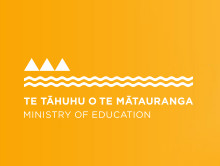Kaiārahi Keakea (wh. 2-11)
nā Nuki Tākao
Hei whakarāpopoto
Ka tae atu a Keakea ki te moutere o Kāpiti, ā, i a ia e noho ana ki reira, ka tuhi i tana rātaka. Ahakoa tekau mā rua noa iho ōna tau, he koi ia ki ngā mahi kaiārahi tūruhi.
Ko Whaea Minnie te tino kaiārahi i te moutere o Kāpiti, engari nā tētahi aituā waka kāore ia i tae ki Kāpiti. Kua riro mā Keakea ngā tūruhi e ārahi i tēnei wā.
Summary
Keakea arrives on Kāpiti Island, and while she is there she writes in her diary. Although she is only twelve, she is a good tourist guide.
Whaea Minnie is the main guide on the island but when an accident occurs on the mainland she is unable to make it to the island. So, it is left to Keakea to guide the tourists this time.
| Te momo reo tuhi Language style |
|
|---|---|
| Ētahi āhuatanga o tēnei momo reo tuhi Features of this language style |
|
I te Ākonga e Pānui ana i te Pukapuka
During Reading
1. Ohia manomanotia tētahi manu, kararehe, ngārara rānei o tō rohe e mōhiotia whānuitia ana e te hapori. Pātaihia ēnei pātai:
- Nō hea taua manu/kararehe/ngārara?
- He aha āna mahi?
- Whakamāramatia mai tōna āhua?
- Kei hea tōna wāhi noho?
- Kei hea ētahi atu wāhi e noho ai taua manu/kararehe/ngārara?
- He aha āna kai?
Whakautua aua pātai, ka tuhi mai i tāu ake kōrero mō taua manu/kararehe/ngārara. Hangaia tāu tuhinga hei pānui whakamārama.
Brainstorm about a bird, animal, or insect that is renowned within your community. Ask the following questions:
- Where is the bird/animal/insect from?
- What does it do?
- What does it look like?
- Where does it live?
- Where else can it be found?
- What does it eat?
When the questions are answered, write your own description of the bird/animal/insect. Present your information as a poster or brochure.
2. He mahi ā-rōpū tēnei, kia takiwhā, kia takirima rānei ki ia rōpū. Ka whakarite mai ngā ākonga i tētahi haerenga mā ngā manuhiri, mā ngā tūruhi rānei. Mā tō rātou kura, mā tō rātou hapori rānei e whakahaere. Wānangahia ēnei pātai e whai ake nei:
- He aha te take o te hui?
- He aha ngā whakahaerenga o te hui?
- He aha ngā whakaritenga mō te hui?
- Ko wai mā ngā manuhiri, ngā kaitautoko?
- He aha ētahi āhuatanga ka kitea?
- Kei a wai ngā mōhiohio hei whakaatu ki a rātou?
- Hangaia mai he whakaaturanga e whakamārama ana i ngā whakaritenga. Ka whakaraupapa mai i ngā kaupapa matua mā tētahi wātaka.
Work in small groups of four or five students to plan an event for visitors or tourists. The event can be run by the school or their community. Use the following questions to plan the event:
- What would the purpose of the event be?
- What would the requirements be?
- How would it be organised?
- Who could attend?
- What would they be able to see?
- Who would have the information to share about the things they plan to see?
- Prepare a presentation explaining these things that need to be done. Include a timetable outlining the sequence of the main events or components of the event.
3. Pānuihia te kōrero. Tuhia ētahi pātai aromatawai mō ngā kaupapa matua o te tuhinga, kia 10 neke atu rānei ngā pātai. Anei ētahi pātai hei tauira pea:
- He aha ngā hiahia a Keakea mō ngā tau e heke mai nei?
- E ai ki te pāpā o Keakea, he aha te tino take kua eke ia ki te taumata hei ārahi tūruhi?
- E pēhea ana te āhua o te wai i te taenga mai o ngā manuhiri?
- He aha te ingoa o te waka?
- I kite ai rātou i tētahi Kiwi?
- He aha ngā mea me maumahara ina kite koe i te kiwi?
Hoatu ō pātai ki tō hoa, māna e whakautu, kātahi ka whakawhitihia kia maakahia e ngā hoa. Mā te pouako e waihangatia mai kia kotahi te tuhinga aroā mō te akomanga katoa rānei.
Read the text. Design a comprehension test, include at least 10 questions. Here are some examples you may want to use:
- What is Keakea aiming to achieve in the future?
- What does her father believe got her to where she is today with her guide work?
- What was the water like when the tourists arrived?
- What is the name of the boat?
- Did they see a kiwi?
- What are the things to remember when you see a kiwi?
When finished get the students to swap tests and mark their responses from their peers. Alternatively the teacher could create a single test from all the questions for the class.



